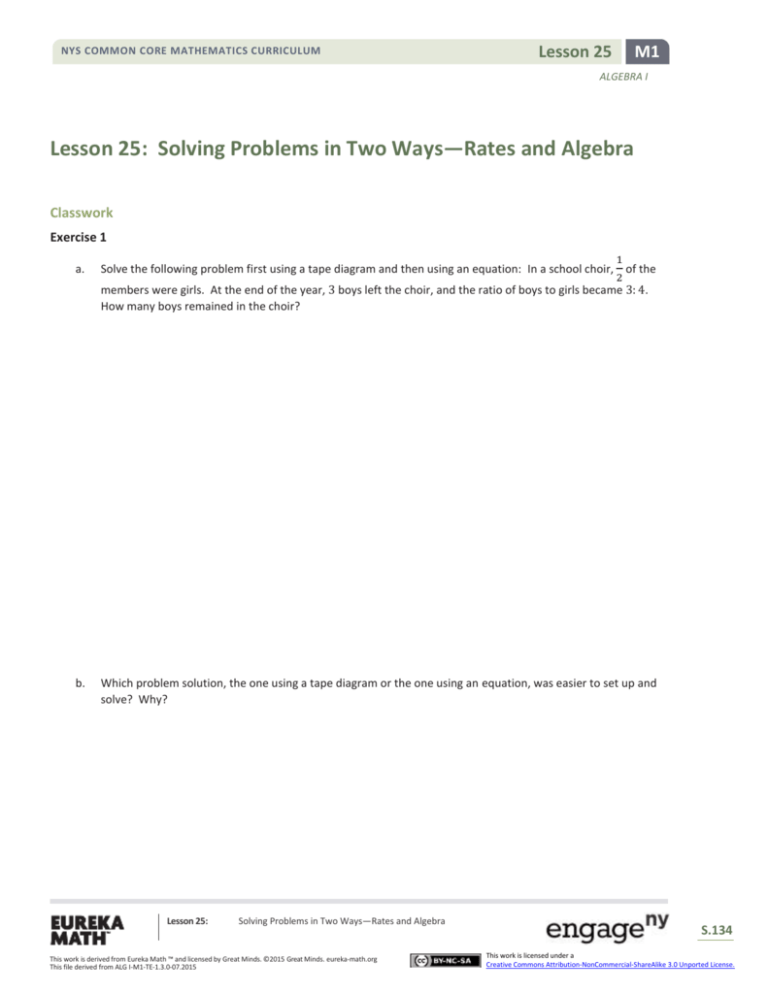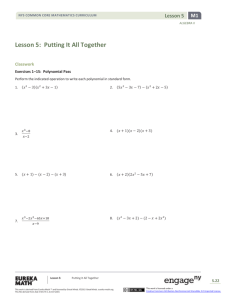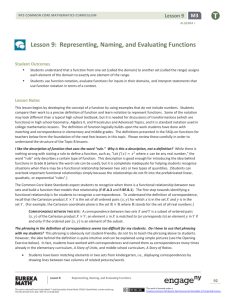Lesson 25 - EngageNY
advertisement

NYS COMMON CORE MATHEMATICS CURRICULUM M1 Lesson 25 ALGEBRA I Lesson 25: Solving Problems in Two Ways—Rates and Algebra Classwork Exercise 1 a. 1 Solve the following problem first using a tape diagram and then using an equation: In a school choir, of the 2 members were girls. At the end of the year, 3 boys left the choir, and the ratio of boys to girls became 3: 4. How many boys remained in the choir? b. Which problem solution, the one using a tape diagram or the one using an equation, was easier to set up and solve? Why? Lesson 25: Solving Problems in Two Ways—Rates and Algebra This work is derived from Eureka Math ™ and licensed by Great Minds. ©2015 Great Minds. eureka-math.org This file derived from ALG I-M1-TE-1.3.0-07.2015 S.134 This work is licensed under a Creative Commons Attribution-NonCommercial-ShareAlike 3.0 Unported License. Lesson 25 NYS COMMON CORE MATHEMATICS CURRICULUM M1 ALGEBRA I Mathematical Modeling Exercise/Exercise 2 Read the following problem: All the printing presses at a print shop were scheduled to make copies of a novel and a cookbook. They were to print the same number of copies of each book, but the novel had twice as many pages as the cookbook. All of the printing presses worked for the first day on the larger book, turning out novels. Then, on day two, the presses were split into two equally sized groups. The first group continued printing copies of the novel and finished printing all the copies by the evening of the second day. The second group worked on the cookbook but did not finish by evening. One printing press, working for two additional full days, finished printing the remaining copies of the cookbooks. If all printing presses printed pages (for both the novel and cookbook) at the same constant rate, how many printing presses are there at the print shop? a. Solve the problem working with rates to setup a tape diagram or an area model. Lesson 25: Solving Problems in Two Ways—Rates and Algebra This work is derived from Eureka Math ™ and licensed by Great Minds. ©2015 Great Minds. eureka-math.org This file derived from ALG I-M1-TE-1.3.0-07.2015 S.135 This work is licensed under a Creative Commons Attribution-NonCommercial-ShareAlike 3.0 Unported License. NYS COMMON CORE MATHEMATICS CURRICULUM Lesson 25 M1 ALGEBRA I b. Solve the problem by setting up an equation. Lesson 25: Solving Problems in Two Ways—Rates and Algebra This work is derived from Eureka Math ™ and licensed by Great Minds. ©2015 Great Minds. eureka-math.org This file derived from ALG I-M1-TE-1.3.0-07.2015 S.136 This work is licensed under a Creative Commons Attribution-NonCommercial-ShareAlike 3.0 Unported License. Lesson 25 NYS COMMON CORE MATHEMATICS CURRICULUM M1 ALGEBRA I Problem Set 1. 2. 3. Solve the following problems first using a tape diagram and then by setting up an equation. For each, give your opinion on which solution method was easier. Can you see the connection(s) between the two methods? What does each “unit” in the tape diagram stand for? a. 16 years from now, Pia’s age will be twice her age 12 years ago. Find her present age. b. The total age of a woman and her son is 51 years. Three years ago, the woman was eight times as old as her son. How old is her son now? c. Five years from now, the sum of the ages of a woman and her daughter will be 40 years. The difference in their present age is 24 years. How old is her daughter now? d. Find three consecutive integers such that their sum is 51. Solve the following problems by setting up an equation or inequality. a. If two numbers represented by (2𝑚 + 1) and (2𝑚 + 5) have a sum of 74, find 𝑚. b. Find two consecutive even numbers such that the sum of the smaller number and twice the greater number is 100. c. If 9 is subtracted from a number, and the result is multiplied by 19, the product is 171. Find the number. d. The product of two consecutive whole numbers is less than the sum of the square of the smaller number and 13. The length, 18 meters, is the answer to the following question. “The length of a rectangle is three meters longer than its width. The area of the rectangle is 270 square meters. What is the length of the rectangle?” Rework this problem: Write an equation using 𝐿 as the length (in meters) of the rectangle that would lead to the solution of the problem. Check that the answer above is correct by substituting 18 for 𝐿 in your equation. 4. 5. Jim tells you he paid a total of $23,078.90 for a car, and you would like to know the price of the car before sales tax so that you can compare the price of that model of car at various dealers. Find the price of the car before sales tax if Jim bought the car in each of the following states: a. Arizona, where the sales tax is 6.6%. b. New York, where the sales tax is 8.25%. c. A state where the sales tax is 𝑠%. A checking account is set up with an initial balance of $9,400, and $800 is removed from the account at the end of each month for rent. (No other user transactions occur on the account.) a. Write an inequality whose solutions are the months, 𝑚, in which the account balance is greater than $3,000. Write the solution set to your equation by identifying all of the solutions. b. Make a graph of the balance in the account after 𝑚 months, and indicate on the plot the solutions to your inequality in part (a). Lesson 25: Solving Problems in Two Ways—Rates and Algebra This work is derived from Eureka Math ™ and licensed by Great Minds. ©2015 Great Minds. eureka-math.org This file derived from ALG I-M1-TE-1.3.0-07.2015 S.137 This work is licensed under a Creative Commons Attribution-NonCommercial-ShareAlike 3.0 Unported License. NYS COMMON CORE MATHEMATICS CURRICULUM Lesson 25 M1 ALGEBRA I 6. 7. Axel and his brother like to play tennis. About three months ago they decided to keep track of how many games each has won. As of today, Axel has won 18 out of the 30 games against his brother. a. How many games would Axel have to win in a row in order to have a 75% winning record? b. How many games would Axel have to win in a row in order to have a 90% winning record? c. Is Axel ever able to reach a 100% winning record? Explain why or why not. d. Suppose that after reaching a winning record of 90% in part (b), Axel had a losing streak. How many games in a row would Axel have to lose in order to drop down to a winning record of 60% again? Omar has $84 and Calina has $12. How much money must Omar give to Calina so that Calina will have three times as much as Omar? a. Solve the problem above by setting up an equation. b. In your opinion, is this problem easier to solve using an equation or using a tape diagram? Why? Lesson 25: Solving Problems in Two Ways—Rates and Algebra This work is derived from Eureka Math ™ and licensed by Great Minds. ©2015 Great Minds. eureka-math.org This file derived from ALG I-M1-TE-1.3.0-07.2015 S.138 This work is licensed under a Creative Commons Attribution-NonCommercial-ShareAlike 3.0 Unported License.










